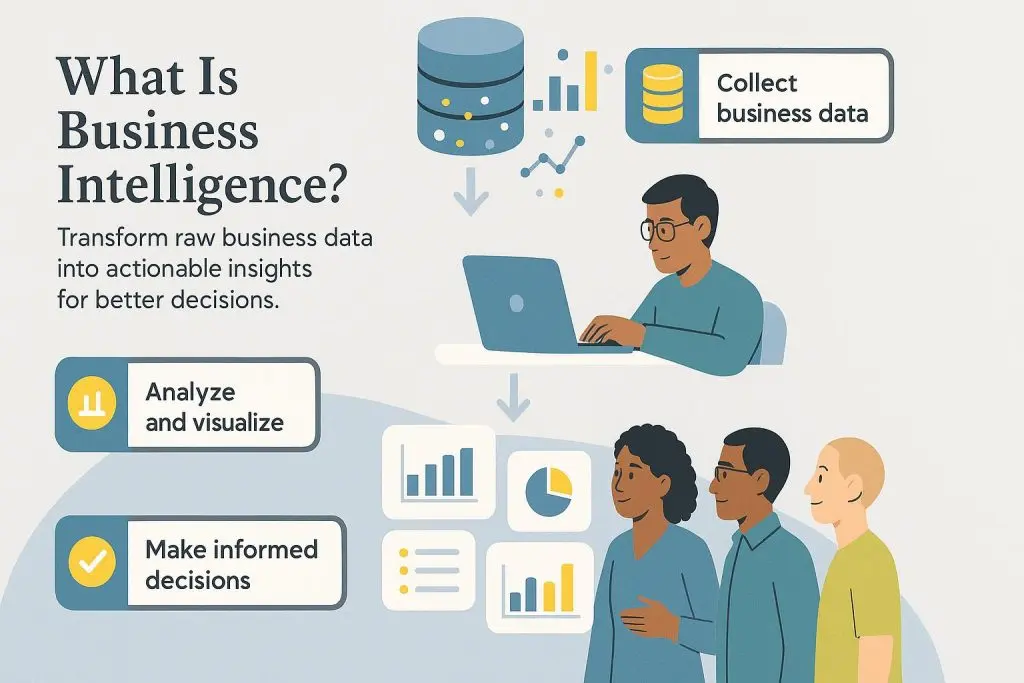Introduction: Why Business Intelligence Matters for Small Businesses
For a long time, Business Intelligence (BI) was seen as a luxury only Fortune 500 companies could afford. Big data warehouses, expensive analytics platforms, and full-time data teams were out of reach for most small businesses.
But in 2025, that’s changed. Affordable, cloud-based BI and analytics tools have democratized access to data insights, giving small and medium-sized businesses (SMBs) the ability to make smarter decisions, optimize operations, and compete with larger players.
This article explores how SMBs can leverage business intelligence and analytics to gain an edge—without enterprise budgets.
1. What Is Business Intelligence (BI)?
Business Intelligence is the process of collecting, analyzing, and visualizing business data to support better decision-making.
Key components include:
- Data Collection – Gathering data from sales, marketing, finance, and operations.
- Data Visualization – Presenting insights through dashboards and charts.
- Predictive Analytics – Using data to forecast future trends.
- Decision Support – Guiding leadership with actionable insights.
In short, BI turns raw data into business clarity.
2. Why BI & Analytics Are Game-Changers for SMBs
Here’s why every small business should care about BI:
- Better Decision-Making – Data-driven choices reduce guesswork.
- Cost Optimization – Identify wasteful spending and streamline operations.
- Customer Understanding – Analyze buying behavior and personalize marketing.
- Competitive Advantage – Spot trends before competitors do.
Example: A small e-commerce store using BI might discover that 60% of its profits come from just 20% of its products—allowing it to focus advertising spend on top performers.
3. Affordable BI & Analytics Tools for SMBs
Gone are the days when BI required a massive budget. Here are affordable (and even free) tools small businesses can start using today:
a) Google Looker Studio (Free)
- Perfect for startups on a budget.
- Integrates with Google Analytics, Sheets, and Ads.
- Create real-time dashboards.
b) Microsoft Power BI ($10/user/month)
- Enterprise-grade analytics at SMB prices.
- Strong data visualization and AI-powered insights.
c) Tableau Public (Free) / Tableau Creator ($70/month)
- Best-in-class visualizations.
- Good for small businesses serious about analytics.
d) Zoho Analytics ($24/month for 2 users)
- Simple setup, ideal for SMBs.
- Great for combining data from multiple sources.
e) Qlik Sense (Free tier available)
- Drag-and-drop dashboards, AI-powered suggestions.
4. Key Metrics Every SMB Should Track
You don’t need to track everything. Focus on metrics that drive business outcomes.
- Revenue & Profit Trends
- Customer Acquisition Cost (CAC)
- Customer Lifetime Value (CLV)
- Website Conversion Rates
- Churn Rate (for subscription businesses)
- Inventory Turnover (for retailers)
👉 Pro tip: Start small. Track 3–5 core KPIs before expanding your dashboard.
5. How to Get Started with BI on a Budget
Step 1: Identify Business Goals
Do you want to boost sales? Improve marketing ROI? Reduce costs? Your BI strategy should support these goals.
Step 2: Gather Data
Start with existing sources like:
- Website analytics
- Social media metrics
- POS (point-of-sale) data
- Accounting software
Step 3: Choose a BI Tool
Pick one tool (e.g., Google Looker Studio) and set up a simple dashboard.
Step 4: Build Dashboards
Visualize key metrics in a way that’s easy to understand at a glance.
Step 5: Review & Act
Data is only valuable if you act on it. Schedule monthly (or weekly) reviews.
6. Common Mistakes to Avoid
Even SMBs using BI can go wrong. Watch out for these pitfalls:
- Tracking Too Much Data – Leads to analysis paralysis.
- Focusing on Vanity Metrics – Likes and followers don’t always equal revenue.
- Not Updating Dashboards – Outdated data leads to bad decisions.
- Ignoring Context – Numbers need context (seasonality, market changes).
7. Future of BI for SMBs
The next wave of BI will be AI-powered, automating much of the analysis and delivering proactive insights.
Imagine this: instead of manually checking dashboards, your BI system alerts you when:
- Inventory is running low
- Customer churn is trending up
- A product is going viral on social media
These features are already rolling out in tools like Power BI, Tableau, and Zoho Analytics—and they’re becoming more accessible each year.
Conclusion: Start Small, Grow Smart
Business Intelligence & Analytics are no longer reserved for enterprises. Even freelancers and small teams can now collect, analyze, and act on data affordably.
The secret is to start simple:
- Pick 3–5 KPIs that matter most.
- Use a free or low-cost tool like Google Looker Studio.
- Review insights regularly and take action.
Over time, your business will become data-driven, allowing you to make faster, smarter, and more profitable decisions—something every SMB needs in today’s competitive market.





